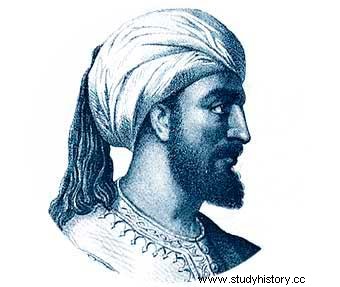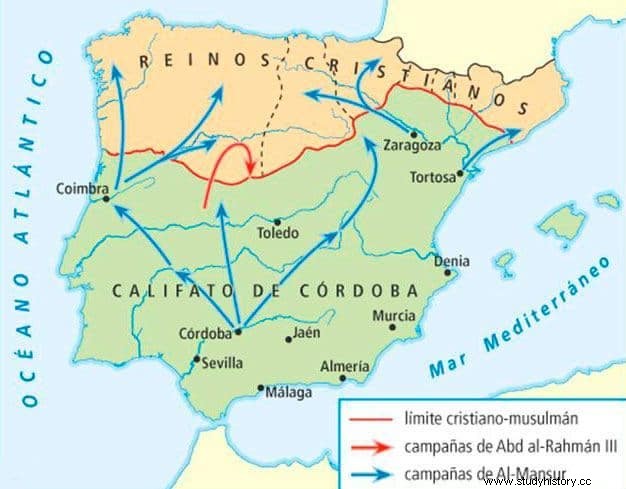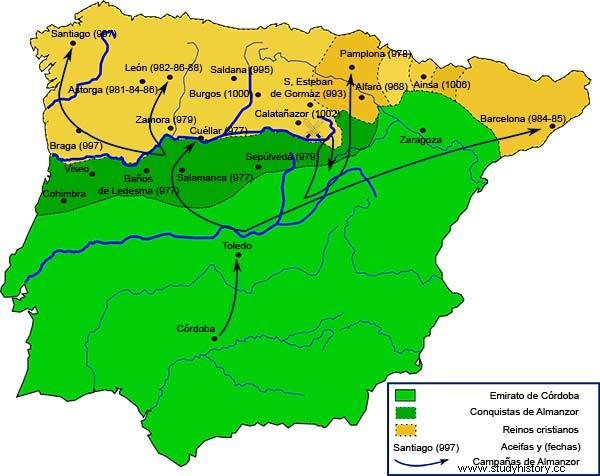The panorama offered by al-Andalus in the last years of the 9th century and the first years of the 10th, in which the emirs al-Mundir (886-888) and Abd Allah (888-912) succeeded each other, was not at all positive. Apart from the revolt of Umar ibn Hafsun, which had reached gigantic proportions, and the almost independentist attitude adopted by the governors of the marches, internal struggles multiplied, in which ethnic, social and political factors intervened. But that situation, which was what Abderramán III found himself in when he acceded to the Emirate in the year 912, changed radically in a very short time. Abderramán III (912-961) managed to pacify the territory of al-Andalus in just a few years . A court poet, Ibn Abd Rabbihí, exalted the military successes of the new emir to incredible limits, writing the following:
At the same time, Abderramán III decided to launch aceifas against the northern Christians, who, at the beginning of the tenth century, taking advantage of the internal disputes in al-Andalus, had advanced across the northern plateau, reaching the Duero line. The most striking success of the Cordovan troops was the victory achieved in Valdejunquera, a town near Pamplona, in the year 920 . Likewise, Abderramán III decided to monitor North Africa, where a new and serious danger had arisen, that of the Fatimids, followers of «Shiism» , who sought to unify Islam under his command. But the most spectacular success of Abderramán III in those years was the crushing of the revolt that, after the death of Umar ibn Hafsun in the year 918, his sons had continued . In 928, the fortress of Bobastro, the center of the rebellion of Umar ibn Hafsun and his successors, fell into power in Cordoba. Abderramán III not only ordered the destruction of Bobastro, but also decided to transfer the body of Umar ibn Hafsun to Córdoba, being crucified and exposed to the people at one of its gates.
Proclamation of Caliph of Abderramán III
Abderramán III decided, in 929, to proclaim himself caliph, creating the Caliphate of Cordoba In a letter sent to his governors, Abderramán III said:«It seems appropriate that, henceforth, we be called Prince of the Believers, and that all the writings that emanate from us or are addressed to us use the same title» . That was a transcendental step, since it meant the definitive rupture, this time in the religious field, with the caliphs of Baghdad. At the same time, Abderramán III adopted the title of "combatant for the religion of Allah" . It is not easy to discern the reasons that pushed Abderramán III to proclaim himself caliph. It is possible that this act had a triumphalist meaning, being something like the crowning of the brilliant triumphs achieved in previous years. But it is also admissible to interpret that fact as the desire of Abderramán III to raise a flag against the dangers that still awaited him, the most important of which was that of the Fatimids of North Africa.

Conquests of Abderramán III
In the following years, Abderramán III continued his victorious march, managing to contain the dissidence of the marks. Particularly hard were the battles held both in Toledo, where the Cordovans entered in the year 932, and in Zaragoza, which capitulated before the Umayyad in the year 937. Likewise, the Cordovan caliph was able to stop the Christian attacks, against which made oils victorious, such as the so-called "Osma campaign" of the year 934. Certainly, Abderramán III also suffered some defeat against the Christians, the most significant of all was that of Simancas-La Alhandega, in the year 939 . But the borders between al-Andalus and the Christian nuclei did not suffer the slightest change. Furthermore, there were Christian kings who were submissive to Abderramán III, as happened with Sancho I de León, who moved to the caliphal capital in 838 to be cured of his obesity. As for North Africa, Abderramán III notably improved his position, to which the conquest, in the year 931, of the city of Ceuta greatly contributed. The indisputable prestige achieved by Abderramán III was highlighted by entering into relations with both the Byzantine Empire and the newborn Germanic Empire. Abderramán III was also the one who ordered the construction, to the west of the city of Córdoba, of the lavish city-palace of Medina Zahara, which became the center of caliphal power .

Caliphate of Al-Hakam II:Cultural period of Al-Andalus
Abderramán III was succeeded in the Cordona Caliphate by his son al-Hakam II (961-976). The stage of his government, which was quite brief, had few shocks, characterized by the indisputable predominance of peace. The only striking aspect was the presence, once again, of the Normans on the western coasts of al-Andalus, which happened in the years 966, around Lisbon, and 971-972 . There was hardly any confrontation with the Christians, although the Muslims decided to rebuild the important fortress of Gormaz, which was an outpost against their enemies to the north. In those years, on the other hand, the embassies to Córdoba of the Christian leaders of the north were frequent; thus, the counts of Castile and Barcelona. The establishment of the Fatimids in Egypt, in the year 969, marked their definitive setback in the Maghreb area. Furthermore, General Galib re-established the Umayyad protectorate in western North Africa. In another order of things, it should be noted that in the times of al-Hakam II, art and culture experienced a spectacular development in al-Andalus, and particularly in the city of Córdoba . It is said, for example, that al-Hakam II managed to put together a library made up of no less than 400,000 volumes. In the field of plastic arts, the most significant aspect of the time of al-Hakam II was the construction, in the main mosque of Córdoba, of the splendid mihrab, in which the ribbed vaults stood out, but also the richness of the materials used. and decorative exuberance.
Caliphate of His-ham II and Government of Ibn Abi Amir
The panorama of al-Andalus experienced, however, a substantial change in the times of the successor of al-Hakam II, His-ham II (976-1009). Since the new caliph was a child, effective power was assumed by his tutor, Ibn Abi Amir , who had started his career in the caliphal court in the modest position of copyist. But in the long run Ibn Abi Amir, a person of great ambition, became the true leader of al-Andalus, while Hisham II became a mere decorative figure. Hence, the stage that opened with the government of Ibn Abi Amir is called the "amirids" . An important step was taken by Ibn Abi Amir in the year 978, when he was appointed hachib, a position that was equivalent to a kind of prime minister. In that same year he ordered the construction, on the outskirts of Córdoba, to the east of the city, of the palace of Medina Zahira, where the central administration of al-Andalus would be installed. Three years later, in 981, Ibn Abi Amir received the nickname "the victorious by Allah" , “al-Mansur bi-llah” in Arabic, from which derives the name by which the Christians called him, that is, Almanzor.
Ibn Abi Amir's Advance and Conquests (Almanzor)
Almanzor, who had above all the support of the Berbers, launched a policy of populist sign. From a religious point of view, he was extremely orthodox, apparently even ordering the destruction of a large part of al-Hakam II's library. But the base of his power was the army, which gives rise to talk of his government as a true military dictatorship. Almanzor carried out numerous and terrifying campaigns against the Christians. Let us remember his most significant successes: in the year 985 the Cordovan troops sacked Barcelona , in 988 they destroyed the Leonese monasteries of Sahagiin and Eslonza, in 997 they victoriously entered Santiago de Compostela (where the tomb of the Apostle was respected) and in 1002 they razed the monastery of San Millán de la Cogolla. However, a few days after this last event, Almanzor died, or, as the Christian sources of the time say, "he was buried in hell."

Abd al-Malik government
A son of Almanzor, Abd al-Malik (1002-1008), succeeded his father in the position he had held. Abd al-Malik, during his brief period of government, kept the military strength of al-Andalus intact, carrying out some victorious raids against the Christians. But the year after his death, in 1009, the Amiri regime ceased to exist. On that same date Caliph Hisham II abdicated . Al-Andalus entered a chaotic phase, the so-called great fitna , which would conclude, a few years later, with the definitive disappearance of the Caliphate of Córdoba.
